Enterprise Systems: IGT's ERP Implementation Analysis and Strategies
VerifiedAdded on 2020/03/01
|7
|1870
|56
Report
AI Summary
This report provides an in-depth analysis of IGT's Enterprise Resource Planning (ERP) system implementation. It begins by outlining the key goals IGT aimed to achieve, including unifying disparate IT systems, remodeling operations for improved efficiency, and coordinating worldwide operations. The report then delves into the pros and cons of customizing the ERP system, discussing the benefits of integrated modules and streamlined information flow, while also acknowledging the high costs and potential implementation challenges. Finally, the report explores IGT's approach to change management during the ERP implementation, emphasizing the importance of effective communication, employee training, and process adjustments to facilitate a smooth transition. The report highlights the significance of understanding the impact of the new system, maintaining clear communication channels, and providing training to ensure employee adaptation to the changes. The report also references the importance of documenting the positive impacts of the ERP system to help employees adjust to the changes. This report is intended to provide a comprehensive overview of the ERP implementation process and the strategies used to maximize its success.
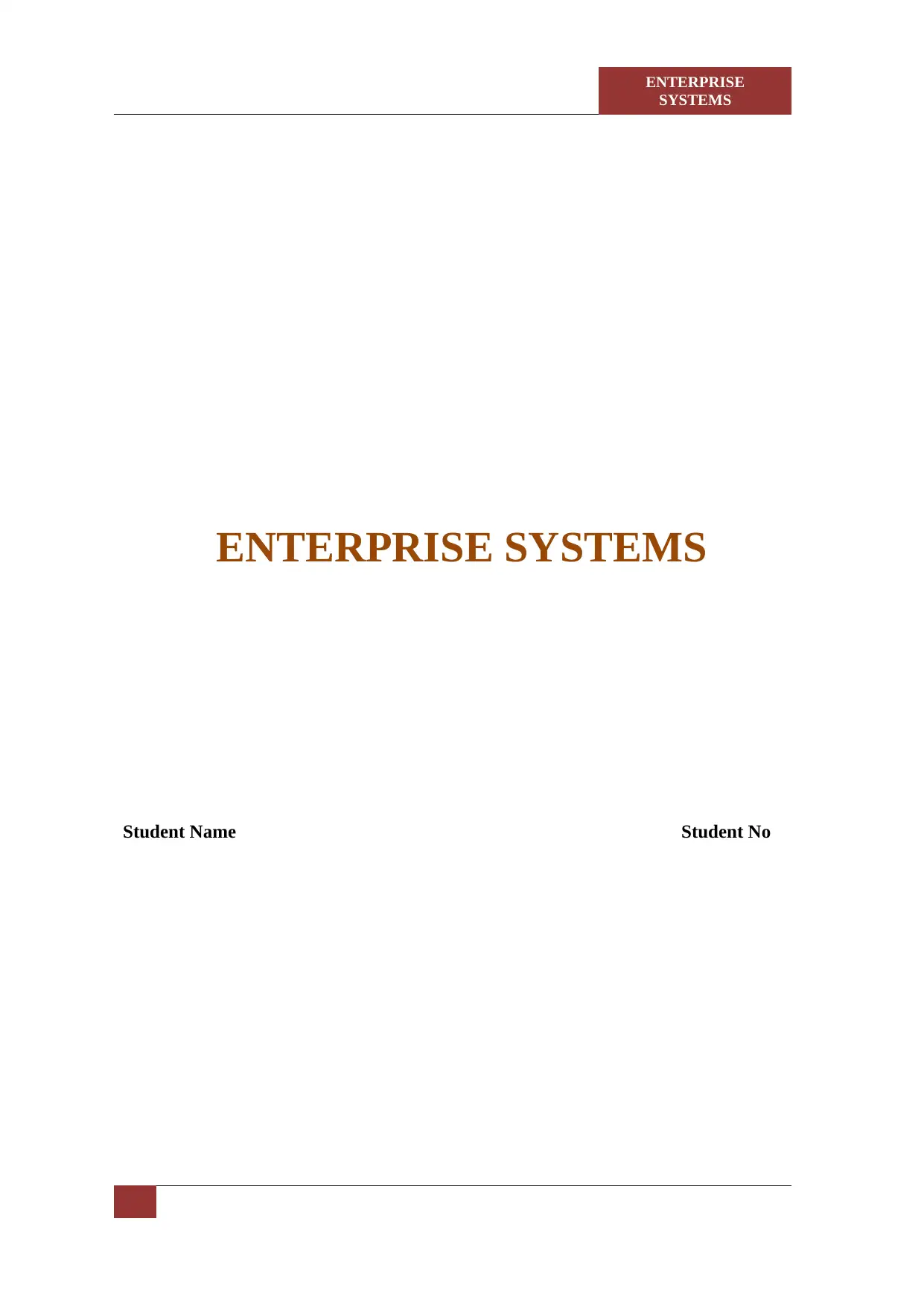
ENTERPRISE
SYSTEMS
ENTERPRISE SYSTEMS
Student Name Student No
SYSTEMS
ENTERPRISE SYSTEMS
Student Name Student No
Paraphrase This Document
Need a fresh take? Get an instant paraphrase of this document with our AI Paraphraser
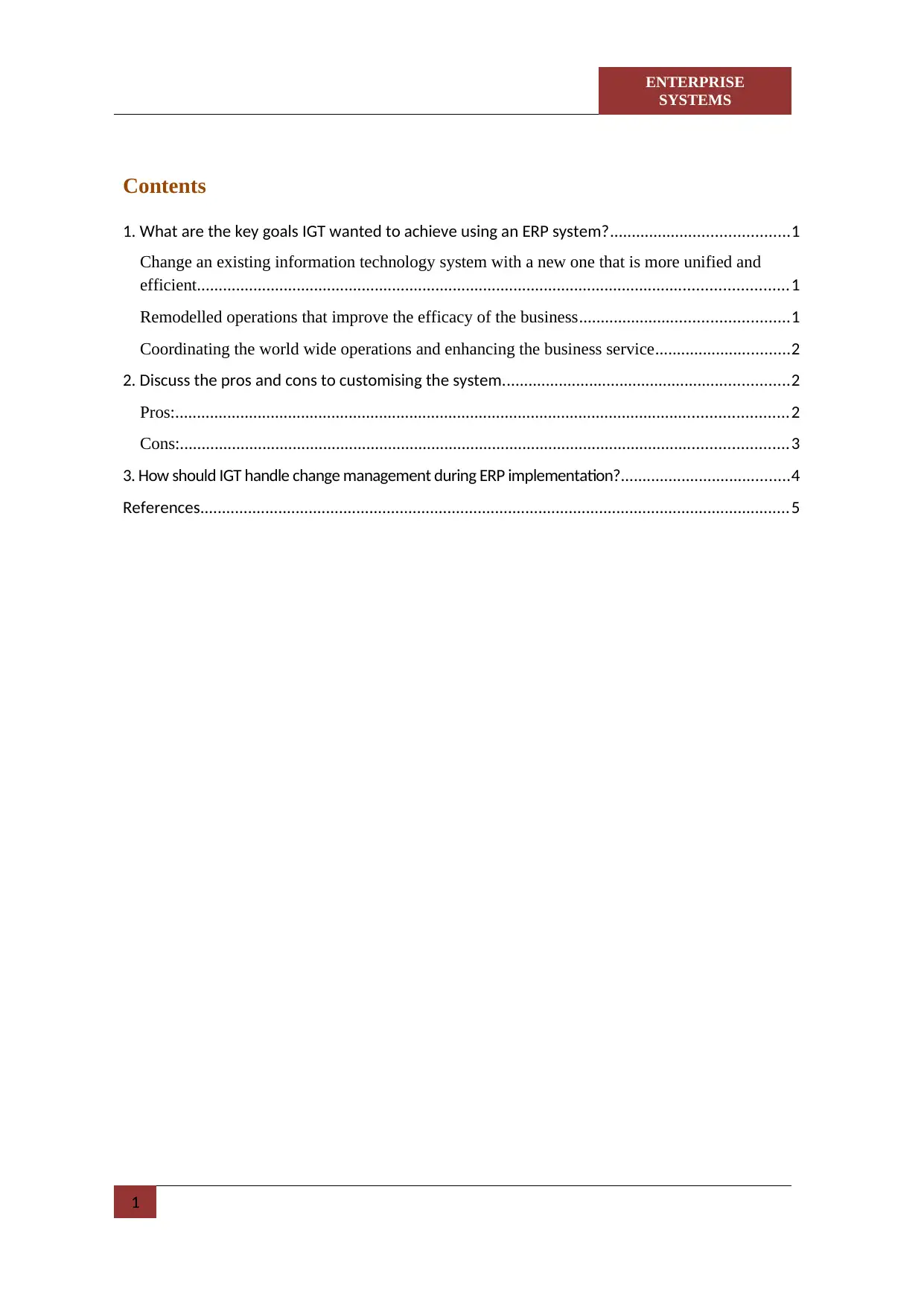
ENTERPRISE
SYSTEMS
Contents
1. What are the key goals IGT wanted to achieve using an ERP system?.........................................1
Change an existing information technology system with a new one that is more unified and
efficient........................................................................................................................................1
Remodelled operations that improve the efficacy of the business................................................1
Coordinating the world wide operations and enhancing the business service...............................2
2. Discuss the pros and cons to customising the system..................................................................2
Pros:.............................................................................................................................................2
Cons:............................................................................................................................................3
3. How should IGT handle change management during ERP implementation?.......................................4
References........................................................................................................................................5
1
SYSTEMS
Contents
1. What are the key goals IGT wanted to achieve using an ERP system?.........................................1
Change an existing information technology system with a new one that is more unified and
efficient........................................................................................................................................1
Remodelled operations that improve the efficacy of the business................................................1
Coordinating the world wide operations and enhancing the business service...............................2
2. Discuss the pros and cons to customising the system..................................................................2
Pros:.............................................................................................................................................2
Cons:............................................................................................................................................3
3. How should IGT handle change management during ERP implementation?.......................................4
References........................................................................................................................................5
1
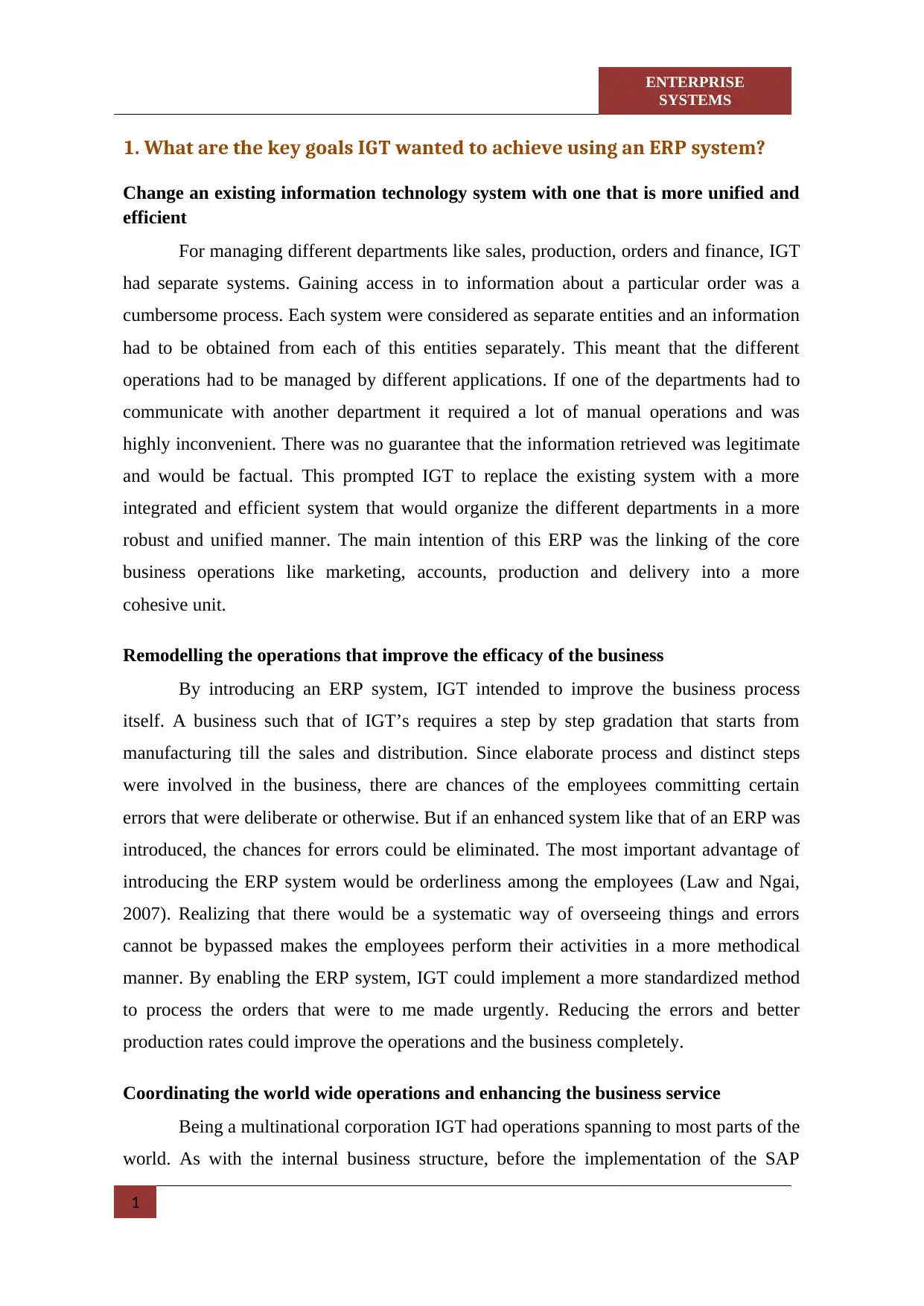
ENTERPRISE
SYSTEMS
1. What are the key goals IGT wanted to achieve using an ERP system?
Change an existing information technology system with one that is more unified and
efficient
For managing different departments like sales, production, orders and finance, IGT
had separate systems. Gaining access in to information about a particular order was a
cumbersome process. Each system were considered as separate entities and an information
had to be obtained from each of this entities separately. This meant that the different
operations had to be managed by different applications. If one of the departments had to
communicate with another department it required a lot of manual operations and was
highly inconvenient. There was no guarantee that the information retrieved was legitimate
and would be factual. This prompted IGT to replace the existing system with a more
integrated and efficient system that would organize the different departments in a more
robust and unified manner. The main intention of this ERP was the linking of the core
business operations like marketing, accounts, production and delivery into a more
cohesive unit.
Remodelling the operations that improve the efficacy of the business
By introducing an ERP system, IGT intended to improve the business process
itself. A business such that of IGT’s requires a step by step gradation that starts from
manufacturing till the sales and distribution. Since elaborate process and distinct steps
were involved in the business, there are chances of the employees committing certain
errors that were deliberate or otherwise. But if an enhanced system like that of an ERP was
introduced, the chances for errors could be eliminated. The most important advantage of
introducing the ERP system would be orderliness among the employees (Law and Ngai,
2007). Realizing that there would be a systematic way of overseeing things and errors
cannot be bypassed makes the employees perform their activities in a more methodical
manner. By enabling the ERP system, IGT could implement a more standardized method
to process the orders that were to me made urgently. Reducing the errors and better
production rates could improve the operations and the business completely.
Coordinating the world wide operations and enhancing the business service
Being a multinational corporation IGT had operations spanning to most parts of the
world. As with the internal business structure, before the implementation of the SAP
1
SYSTEMS
1. What are the key goals IGT wanted to achieve using an ERP system?
Change an existing information technology system with one that is more unified and
efficient
For managing different departments like sales, production, orders and finance, IGT
had separate systems. Gaining access in to information about a particular order was a
cumbersome process. Each system were considered as separate entities and an information
had to be obtained from each of this entities separately. This meant that the different
operations had to be managed by different applications. If one of the departments had to
communicate with another department it required a lot of manual operations and was
highly inconvenient. There was no guarantee that the information retrieved was legitimate
and would be factual. This prompted IGT to replace the existing system with a more
integrated and efficient system that would organize the different departments in a more
robust and unified manner. The main intention of this ERP was the linking of the core
business operations like marketing, accounts, production and delivery into a more
cohesive unit.
Remodelling the operations that improve the efficacy of the business
By introducing an ERP system, IGT intended to improve the business process
itself. A business such that of IGT’s requires a step by step gradation that starts from
manufacturing till the sales and distribution. Since elaborate process and distinct steps
were involved in the business, there are chances of the employees committing certain
errors that were deliberate or otherwise. But if an enhanced system like that of an ERP was
introduced, the chances for errors could be eliminated. The most important advantage of
introducing the ERP system would be orderliness among the employees (Law and Ngai,
2007). Realizing that there would be a systematic way of overseeing things and errors
cannot be bypassed makes the employees perform their activities in a more methodical
manner. By enabling the ERP system, IGT could implement a more standardized method
to process the orders that were to me made urgently. Reducing the errors and better
production rates could improve the operations and the business completely.
Coordinating the world wide operations and enhancing the business service
Being a multinational corporation IGT had operations spanning to most parts of the
world. As with the internal business structure, before the implementation of the SAP
1
⊘ This is a preview!⊘
Do you want full access?
Subscribe today to unlock all pages.

Trusted by 1+ million students worldwide
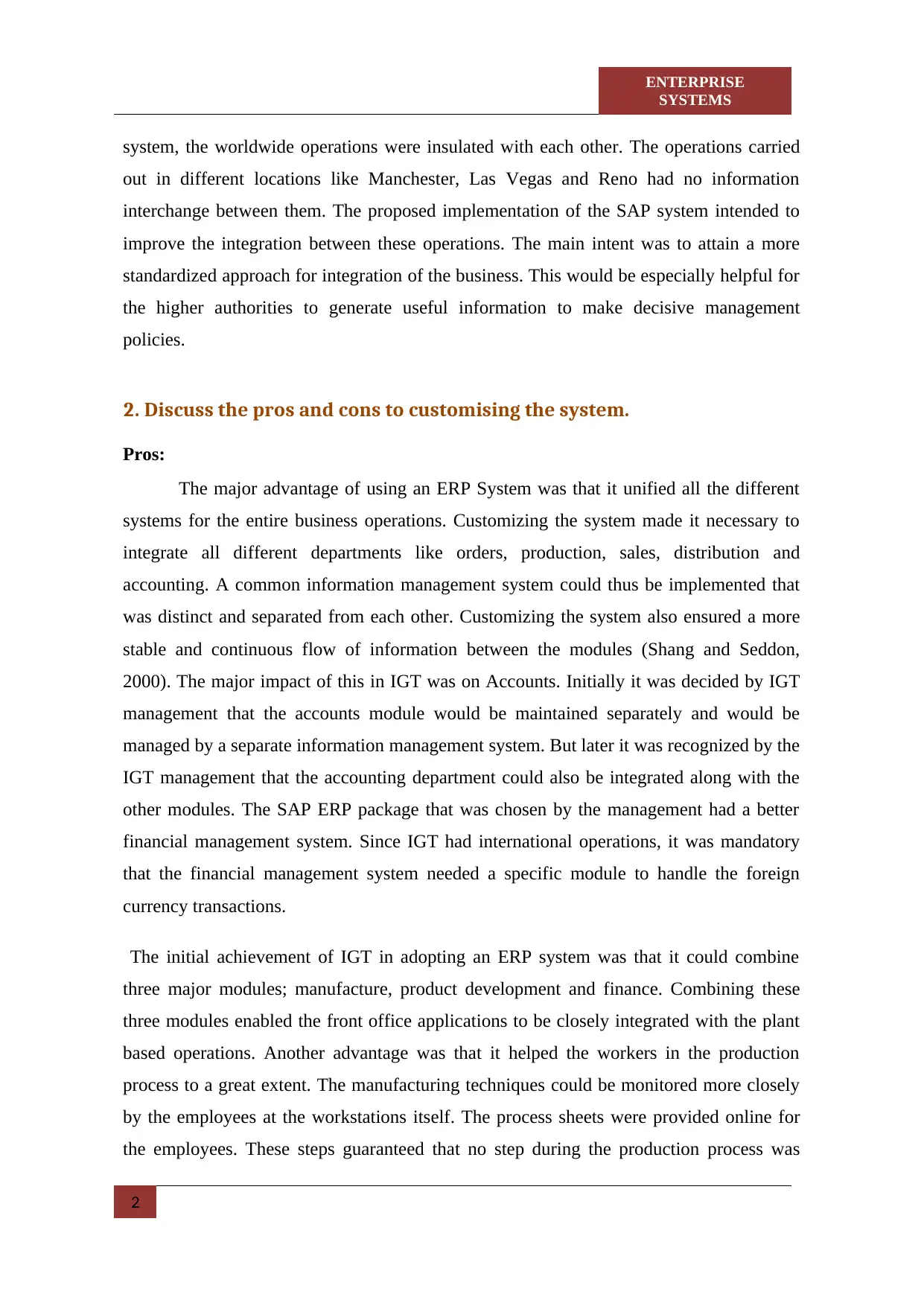
ENTERPRISE
SYSTEMS
system, the worldwide operations were insulated with each other. The operations carried
out in different locations like Manchester, Las Vegas and Reno had no information
interchange between them. The proposed implementation of the SAP system intended to
improve the integration between these operations. The main intent was to attain a more
standardized approach for integration of the business. This would be especially helpful for
the higher authorities to generate useful information to make decisive management
policies.
2. Discuss the pros and cons to customising the system.
Pros:
The major advantage of using an ERP System was that it unified all the different
systems for the entire business operations. Customizing the system made it necessary to
integrate all different departments like orders, production, sales, distribution and
accounting. A common information management system could thus be implemented that
was distinct and separated from each other. Customizing the system also ensured a more
stable and continuous flow of information between the modules (Shang and Seddon,
2000). The major impact of this in IGT was on Accounts. Initially it was decided by IGT
management that the accounts module would be maintained separately and would be
managed by a separate information management system. But later it was recognized by the
IGT management that the accounting department could also be integrated along with the
other modules. The SAP ERP package that was chosen by the management had a better
financial management system. Since IGT had international operations, it was mandatory
that the financial management system needed a specific module to handle the foreign
currency transactions.
The initial achievement of IGT in adopting an ERP system was that it could combine
three major modules; manufacture, product development and finance. Combining these
three modules enabled the front office applications to be closely integrated with the plant
based operations. Another advantage was that it helped the workers in the production
process to a great extent. The manufacturing techniques could be monitored more closely
by the employees at the workstations itself. The process sheets were provided online for
the employees. These steps guaranteed that no step during the production process was
2
SYSTEMS
system, the worldwide operations were insulated with each other. The operations carried
out in different locations like Manchester, Las Vegas and Reno had no information
interchange between them. The proposed implementation of the SAP system intended to
improve the integration between these operations. The main intent was to attain a more
standardized approach for integration of the business. This would be especially helpful for
the higher authorities to generate useful information to make decisive management
policies.
2. Discuss the pros and cons to customising the system.
Pros:
The major advantage of using an ERP System was that it unified all the different
systems for the entire business operations. Customizing the system made it necessary to
integrate all different departments like orders, production, sales, distribution and
accounting. A common information management system could thus be implemented that
was distinct and separated from each other. Customizing the system also ensured a more
stable and continuous flow of information between the modules (Shang and Seddon,
2000). The major impact of this in IGT was on Accounts. Initially it was decided by IGT
management that the accounts module would be maintained separately and would be
managed by a separate information management system. But later it was recognized by the
IGT management that the accounting department could also be integrated along with the
other modules. The SAP ERP package that was chosen by the management had a better
financial management system. Since IGT had international operations, it was mandatory
that the financial management system needed a specific module to handle the foreign
currency transactions.
The initial achievement of IGT in adopting an ERP system was that it could combine
three major modules; manufacture, product development and finance. Combining these
three modules enabled the front office applications to be closely integrated with the plant
based operations. Another advantage was that it helped the workers in the production
process to a great extent. The manufacturing techniques could be monitored more closely
by the employees at the workstations itself. The process sheets were provided online for
the employees. These steps guaranteed that no step during the production process was
2
Paraphrase This Document
Need a fresh take? Get an instant paraphrase of this document with our AI Paraphraser
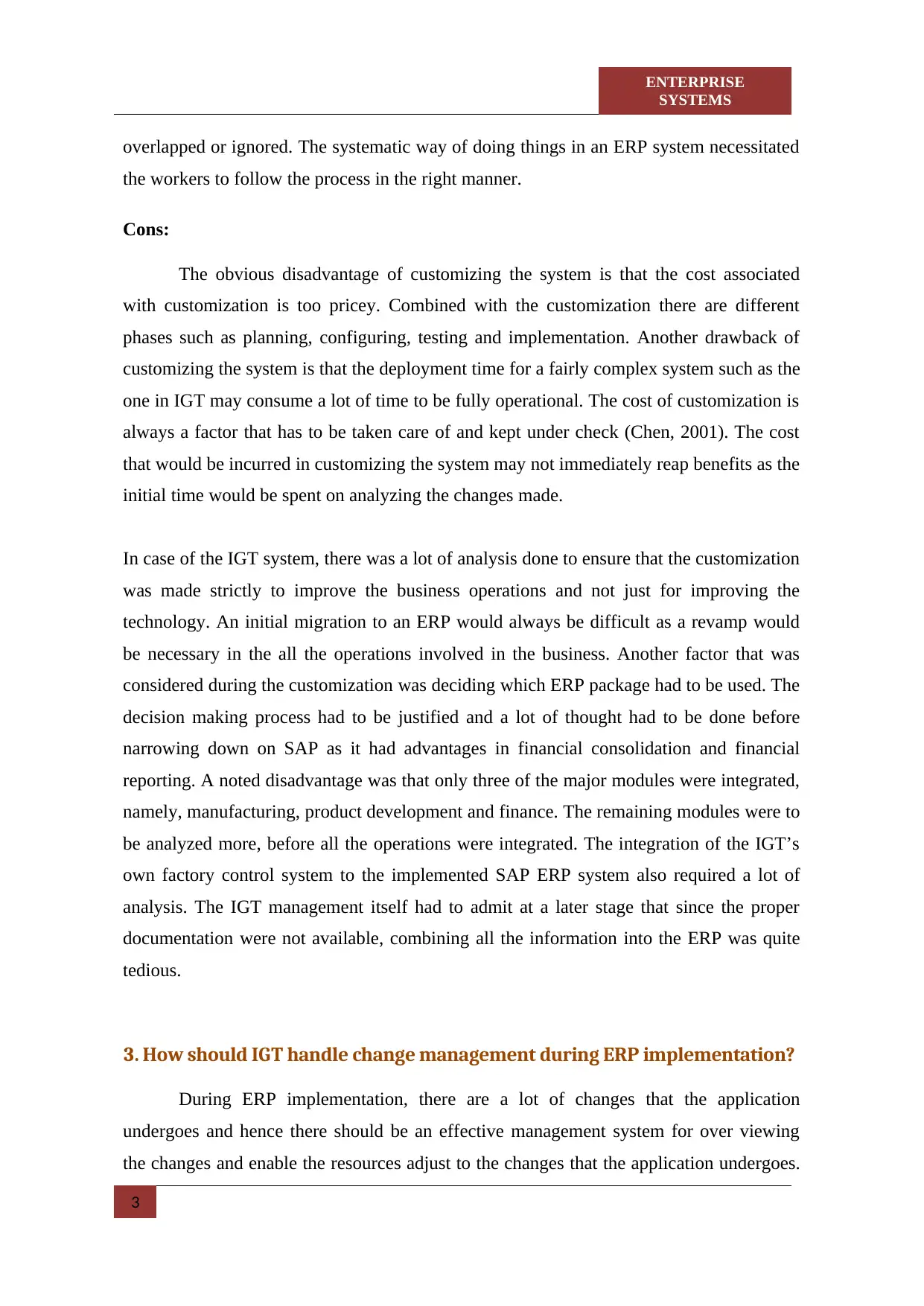
ENTERPRISE
SYSTEMS
overlapped or ignored. The systematic way of doing things in an ERP system necessitated
the workers to follow the process in the right manner.
Cons:
The obvious disadvantage of customizing the system is that the cost associated
with customization is too pricey. Combined with the customization there are different
phases such as planning, configuring, testing and implementation. Another drawback of
customizing the system is that the deployment time for a fairly complex system such as the
one in IGT may consume a lot of time to be fully operational. The cost of customization is
always a factor that has to be taken care of and kept under check (Chen, 2001). The cost
that would be incurred in customizing the system may not immediately reap benefits as the
initial time would be spent on analyzing the changes made.
In case of the IGT system, there was a lot of analysis done to ensure that the customization
was made strictly to improve the business operations and not just for improving the
technology. An initial migration to an ERP would always be difficult as a revamp would
be necessary in the all the operations involved in the business. Another factor that was
considered during the customization was deciding which ERP package had to be used. The
decision making process had to be justified and a lot of thought had to be done before
narrowing down on SAP as it had advantages in financial consolidation and financial
reporting. A noted disadvantage was that only three of the major modules were integrated,
namely, manufacturing, product development and finance. The remaining modules were to
be analyzed more, before all the operations were integrated. The integration of the IGT’s
own factory control system to the implemented SAP ERP system also required a lot of
analysis. The IGT management itself had to admit at a later stage that since the proper
documentation were not available, combining all the information into the ERP was quite
tedious.
3. How should IGT handle change management during ERP implementation?
During ERP implementation, there are a lot of changes that the application
undergoes and hence there should be an effective management system for over viewing
the changes and enable the resources adjust to the changes that the application undergoes.
3
SYSTEMS
overlapped or ignored. The systematic way of doing things in an ERP system necessitated
the workers to follow the process in the right manner.
Cons:
The obvious disadvantage of customizing the system is that the cost associated
with customization is too pricey. Combined with the customization there are different
phases such as planning, configuring, testing and implementation. Another drawback of
customizing the system is that the deployment time for a fairly complex system such as the
one in IGT may consume a lot of time to be fully operational. The cost of customization is
always a factor that has to be taken care of and kept under check (Chen, 2001). The cost
that would be incurred in customizing the system may not immediately reap benefits as the
initial time would be spent on analyzing the changes made.
In case of the IGT system, there was a lot of analysis done to ensure that the customization
was made strictly to improve the business operations and not just for improving the
technology. An initial migration to an ERP would always be difficult as a revamp would
be necessary in the all the operations involved in the business. Another factor that was
considered during the customization was deciding which ERP package had to be used. The
decision making process had to be justified and a lot of thought had to be done before
narrowing down on SAP as it had advantages in financial consolidation and financial
reporting. A noted disadvantage was that only three of the major modules were integrated,
namely, manufacturing, product development and finance. The remaining modules were to
be analyzed more, before all the operations were integrated. The integration of the IGT’s
own factory control system to the implemented SAP ERP system also required a lot of
analysis. The IGT management itself had to admit at a later stage that since the proper
documentation were not available, combining all the information into the ERP was quite
tedious.
3. How should IGT handle change management during ERP implementation?
During ERP implementation, there are a lot of changes that the application
undergoes and hence there should be an effective management system for over viewing
the changes and enable the resources adjust to the changes that the application undergoes.
3
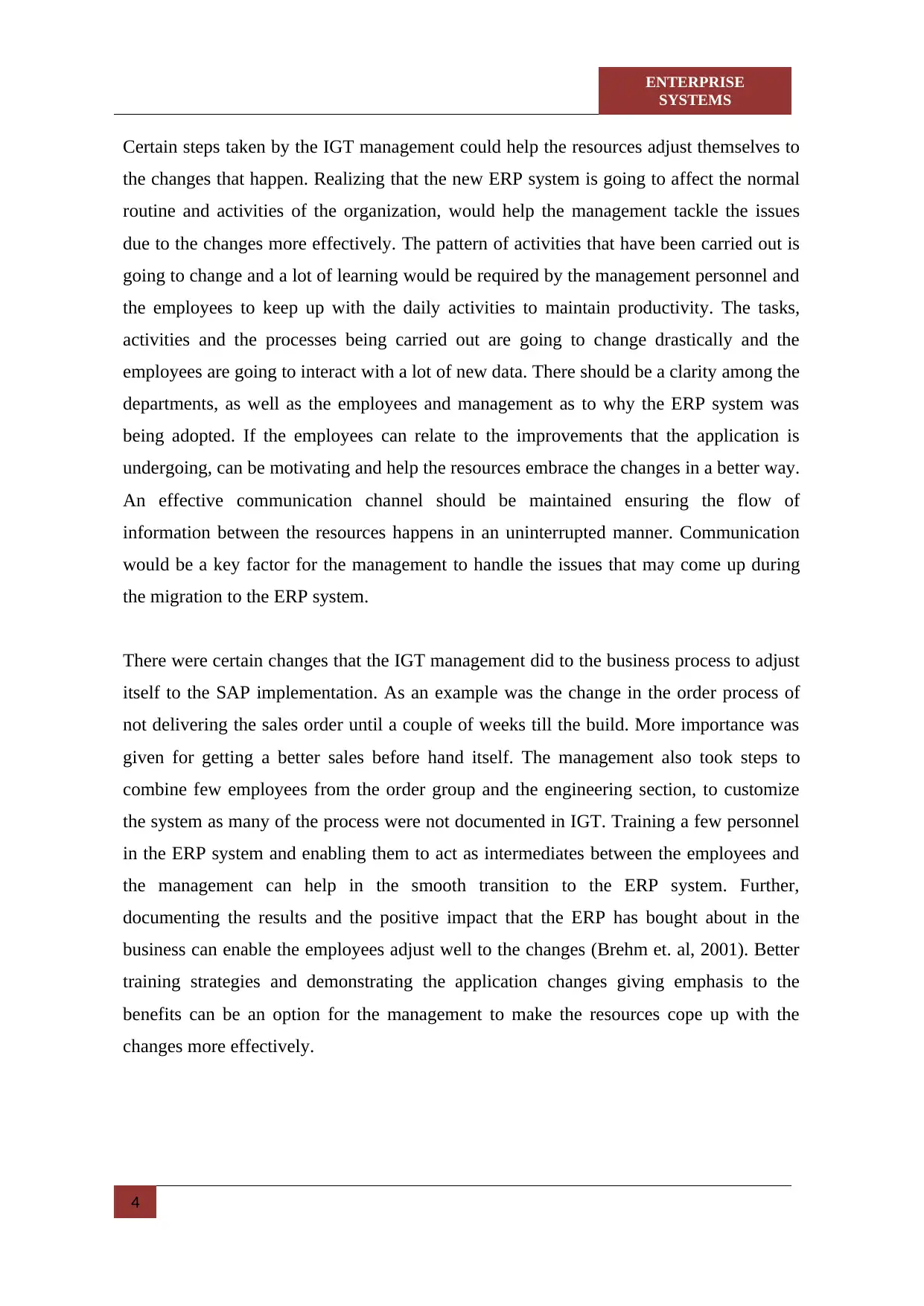
ENTERPRISE
SYSTEMS
Certain steps taken by the IGT management could help the resources adjust themselves to
the changes that happen. Realizing that the new ERP system is going to affect the normal
routine and activities of the organization, would help the management tackle the issues
due to the changes more effectively. The pattern of activities that have been carried out is
going to change and a lot of learning would be required by the management personnel and
the employees to keep up with the daily activities to maintain productivity. The tasks,
activities and the processes being carried out are going to change drastically and the
employees are going to interact with a lot of new data. There should be a clarity among the
departments, as well as the employees and management as to why the ERP system was
being adopted. If the employees can relate to the improvements that the application is
undergoing, can be motivating and help the resources embrace the changes in a better way.
An effective communication channel should be maintained ensuring the flow of
information between the resources happens in an uninterrupted manner. Communication
would be a key factor for the management to handle the issues that may come up during
the migration to the ERP system.
There were certain changes that the IGT management did to the business process to adjust
itself to the SAP implementation. As an example was the change in the order process of
not delivering the sales order until a couple of weeks till the build. More importance was
given for getting a better sales before hand itself. The management also took steps to
combine few employees from the order group and the engineering section, to customize
the system as many of the process were not documented in IGT. Training a few personnel
in the ERP system and enabling them to act as intermediates between the employees and
the management can help in the smooth transition to the ERP system. Further,
documenting the results and the positive impact that the ERP has bought about in the
business can enable the employees adjust well to the changes (Brehm et. al, 2001). Better
training strategies and demonstrating the application changes giving emphasis to the
benefits can be an option for the management to make the resources cope up with the
changes more effectively.
4
SYSTEMS
Certain steps taken by the IGT management could help the resources adjust themselves to
the changes that happen. Realizing that the new ERP system is going to affect the normal
routine and activities of the organization, would help the management tackle the issues
due to the changes more effectively. The pattern of activities that have been carried out is
going to change and a lot of learning would be required by the management personnel and
the employees to keep up with the daily activities to maintain productivity. The tasks,
activities and the processes being carried out are going to change drastically and the
employees are going to interact with a lot of new data. There should be a clarity among the
departments, as well as the employees and management as to why the ERP system was
being adopted. If the employees can relate to the improvements that the application is
undergoing, can be motivating and help the resources embrace the changes in a better way.
An effective communication channel should be maintained ensuring the flow of
information between the resources happens in an uninterrupted manner. Communication
would be a key factor for the management to handle the issues that may come up during
the migration to the ERP system.
There were certain changes that the IGT management did to the business process to adjust
itself to the SAP implementation. As an example was the change in the order process of
not delivering the sales order until a couple of weeks till the build. More importance was
given for getting a better sales before hand itself. The management also took steps to
combine few employees from the order group and the engineering section, to customize
the system as many of the process were not documented in IGT. Training a few personnel
in the ERP system and enabling them to act as intermediates between the employees and
the management can help in the smooth transition to the ERP system. Further,
documenting the results and the positive impact that the ERP has bought about in the
business can enable the employees adjust well to the changes (Brehm et. al, 2001). Better
training strategies and demonstrating the application changes giving emphasis to the
benefits can be an option for the management to make the resources cope up with the
changes more effectively.
4
⊘ This is a preview!⊘
Do you want full access?
Subscribe today to unlock all pages.

Trusted by 1+ million students worldwide
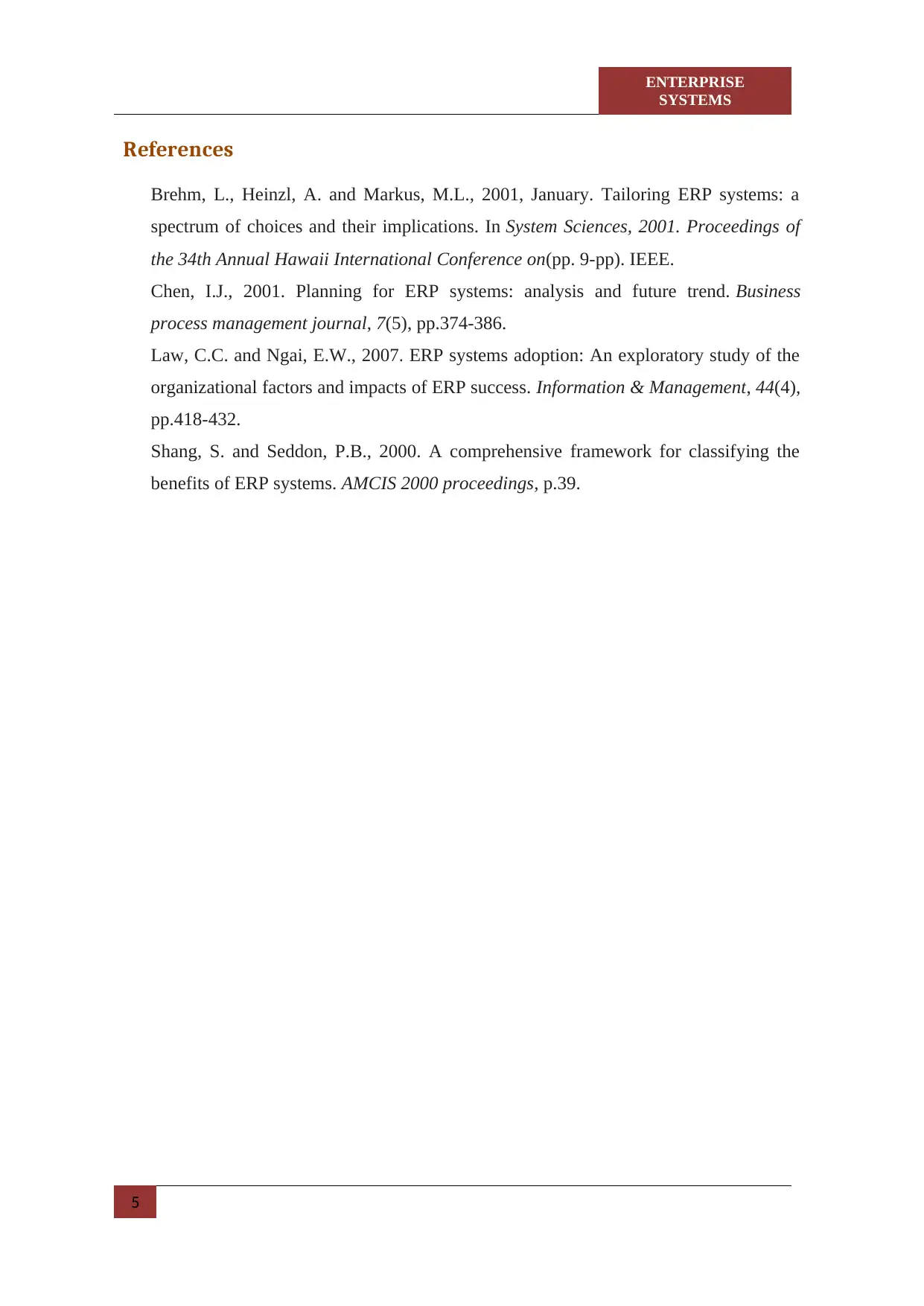
ENTERPRISE
SYSTEMS
References
Brehm, L., Heinzl, A. and Markus, M.L., 2001, January. Tailoring ERP systems: a
spectrum of choices and their implications. In System Sciences, 2001. Proceedings of
the 34th Annual Hawaii International Conference on(pp. 9-pp). IEEE.
Chen, I.J., 2001. Planning for ERP systems: analysis and future trend. Business
process management journal, 7(5), pp.374-386.
Law, C.C. and Ngai, E.W., 2007. ERP systems adoption: An exploratory study of the
organizational factors and impacts of ERP success. Information & Management, 44(4),
pp.418-432.
Shang, S. and Seddon, P.B., 2000. A comprehensive framework for classifying the
benefits of ERP systems. AMCIS 2000 proceedings, p.39.
5
SYSTEMS
References
Brehm, L., Heinzl, A. and Markus, M.L., 2001, January. Tailoring ERP systems: a
spectrum of choices and their implications. In System Sciences, 2001. Proceedings of
the 34th Annual Hawaii International Conference on(pp. 9-pp). IEEE.
Chen, I.J., 2001. Planning for ERP systems: analysis and future trend. Business
process management journal, 7(5), pp.374-386.
Law, C.C. and Ngai, E.W., 2007. ERP systems adoption: An exploratory study of the
organizational factors and impacts of ERP success. Information & Management, 44(4),
pp.418-432.
Shang, S. and Seddon, P.B., 2000. A comprehensive framework for classifying the
benefits of ERP systems. AMCIS 2000 proceedings, p.39.
5
1 out of 7
Related Documents
Your All-in-One AI-Powered Toolkit for Academic Success.
+13062052269
info@desklib.com
Available 24*7 on WhatsApp / Email
![[object Object]](/_next/static/media/star-bottom.7253800d.svg)
Unlock your academic potential
Copyright © 2020–2025 A2Z Services. All Rights Reserved. Developed and managed by ZUCOL.





